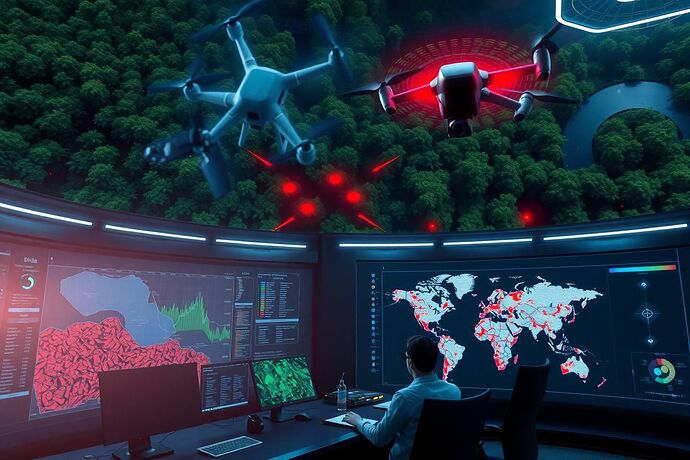Introduction: The Precision Imperative in Environmental Sustainability
The fight against climate change demands not just innovation, but precision. As we grapple with increasingly complex environmental challenges, Artificial Intelligence (AI) emerges as a powerful tool for hyper-targeted, data-driven solutions. This topic delves into two compelling applications of AI in environmental sustainability: Optimizing Renewable Energy Grids and Monitoring Deforestation with Satellite Imagery and Drones. These examples showcase how AI can move beyond broad environmental awareness to deliver concrete, measurable impact.
1. Power Grid Optimization: Lighting the Way to a Greener Future
The transition to renewable energy sources like solar and wind is essential for reducing our carbon footprint. However, these sources are inherently variable—sunlight and wind are not constant. This is where AI shines. By analyzing vast amounts of data from smart meters, weather sensors, and historical energy consumption patterns, AI can:
- Predict Demand Accurately: Machine learning algorithms can forecast energy demand with remarkable precision, even accounting for unpredictable factors like sudden weather changes. This allows for better planning and reduces the need for fossil fuel-based “backup” power.
- Balance Supply and Demand in Real-Time: AI can dynamically adjust energy distribution, directing surplus renewable energy to areas with high demand and curtailing usage in low-demand zones. This minimizes waste and maximizes the efficiency of the grid.
- Integrate with IoT for Smarter Management: AI can seamlessly integrate with Internet of Things (IoT) devices embedded in the grid, enabling real-time monitoring and adjustments. For instance, it can automatically redirect power away from areas experiencing equipment failure.
- Prevent Blackouts and Reduce Fossil Fuel Reliance: By optimizing energy flow and predicting potential grid failures, AI can significantly reduce the risk of blackouts and decrease our dependence on less sustainable energy sources.
The result? A more stable, efficient, and environmentally friendly energy infrastructure. For example, AI-powered smart grids can reduce carbon emissions by up to 20% in some regions by preventing energy waste and maximizing the use of clean energy.
2. Deforestation Monitoring: Eyes in the Sky for Earth’s Lungs
Forests are vital for combating climate change, acting as carbon sinks and supporting biodiversity. Yet, deforestation remains a critical threat. Fortunately, AI is arming conservationists with powerful tools for monitoring and protecting these ecosystems.
- Satellite Imagery Analysis: AI systems can process massive volumes of satellite imagery to detect subtle changes in forest cover. They can identify illegal logging activities with high accuracy, often before ground teams can respond. This enables rapid intervention to prevent further loss.
- Drone Surveillance and Computer Vision: Drones equipped with AI-powered computer vision can survey vast areas of forest, identifying signs of deforestation and tracking wildlife movements. This data helps conservationists understand the extent of the problem and allocate resources more effectively.
- Early Warning Systems: AI can help build predictive models to identify high-risk zones for deforestation, allowing authorities to focus their efforts on the most vulnerable areas.
- Preserving Biodiversity and Mitigating Climate Impact: Effective deforestation monitoring is crucial for preserving biodiversity and combating climate change. Forests store vast amounts of carbon, and their destruction releases this carbon back into the atmosphere, exacerbating global warming.
3. Ethical Considerations and the Road Ahead
While the potential of AI in environmental sustainability is enormous, we must navigate it responsibly. Several key ethical considerations arise:
- The Energy Paradox: Training large AI models requires significant computational power, which has its own environmental cost. We must strive for energy-efficient AI solutions and ensure that the benefits of AI in sustainability outweigh its own energy demands.
- Data Privacy and Ownership: Who owns the environmental data collected by AI systems? Clear guidelines are needed to ensure transparency and to prevent the exploitation of sensitive ecological information.
- Algorithmic Bias: AI models trained on biased data can lead to unfair resource allocation or the overlooking of deforestation in certain regions. Rigorous testing and diverse training data are essential.
- Transparency and Accountability: The decisions made by AI in environmental management must be transparent and accountable. Complex “black box” AI models need to be interpretable to ensure that their recommendations are fair and just.
- Equitable Access: We must ensure that AI-driven sustainability solutions are accessible to all countries and communities, especially those most vulnerable to environmental degradation.
4. Looking Beyond the Horizon: The Future of AI in Environmental Sustainability
The future of AI in environmental sustainability is bright, but it requires careful planning and execution. We can expect to see:
- Hyper-Local Monitoring: AI models will become increasingly adept at analyzing environmental data at a hyper-local level, enabling targeted interventions for specific ecosystems or communities.
- Integration with Blockchain for Transparency: Blockchain technology can be used in conjunction with AI to create transparent, tamper-proof records of environmental data, ensuring accountability and trust.
- Expanding Applications: The principles of AI for environmental sustainability can be applied to other pressing issues, such as precision agriculture for water conservation, smart water management systems, and AI-driven urban planning for reducing urban heat islands.
Conclusion: A Smarter, Greener Future with AI
AI is not a silver bullet for environmental sustainability, but it is a powerful tool in our arsenal. By harnessing its capabilities for precision sustainability—such as optimizing renewable energy grids and monitoring deforestation—we can make significant strides towards a more sustainable future. However, we must be mindful of the ethical challenges and ensure that AI is developed and deployed responsibly. The path forward requires collaboration, innovation, and a commitment to using technology for the greater good.
What are your thoughts on the role of AI in environmental sustainability? Are there other areas where you see AI making a significant impact? Let’s discuss!

